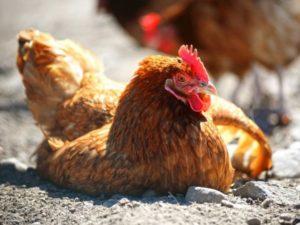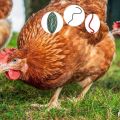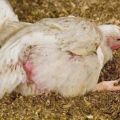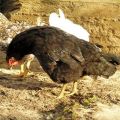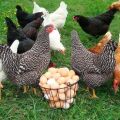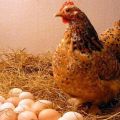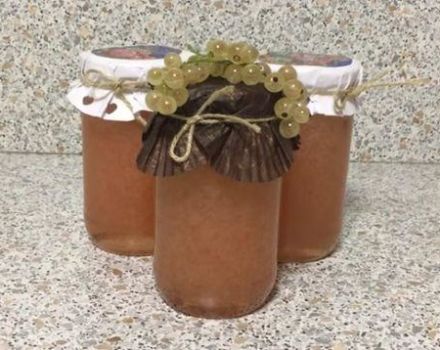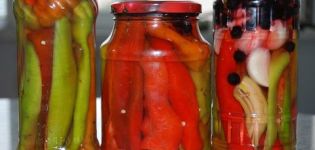Causes and symptoms of leg diseases in chickens, treatment methods
Leg diseases in chickens can occur for various reasons. In some cases, birds hatch with an infection that manifests itself in an adult. However, problems can arise as a result of contamination that can spread to the entire chicken coop.
Common causes of paw diseases
Leg disease in chickens can occur as a result of various reasons. Most often, the following are distinguished:
- improper maintenance and insufficient space for movement in the chicken coop;
- improper selection of food products;
- gout disease;
- chicken lameness;
- the use of drugs to accelerate growth;
- improper metabolism;
- lack of vitamins in the body of the bird.
In some cases, the disease may appear as a result of genetic factors, which cannot be changed with the help of drugs.
Symptoms and treatment of leg diseases in chickens
When chickens develop leg problems, many poultry farmers incorrectly determine the type of disease and do not take the necessary measures. It is important to consider all symptoms and signs when identifying the cause of the problem.
Vitamin deficiency
The lack of vitamins is associated with an incorrect distribution of the foods that are eaten by the chicken. As a result of a lack of the necessary elements in a bird, the following symptoms may be observed:
- Lack of vitamin A - decreased appetite, apathy, the formation of small ulcers on the paws, which may increase.
- Vitamins of group B (B1, B2, B12) - convulsions, the bird cannot stand on its paws, the crest is blue, and the appetite decreases.
- Vitamin D - chicken grows poorly, growth of limbs slows down. Feet can be deformed and weak. In laying hens, eggs appear with a thin skin.
- Vitamin E - weakness in the paws, lameness appears. Toes curl up and grow overgrown.
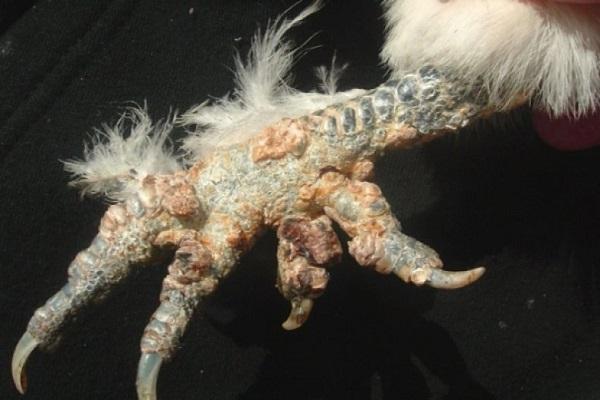
In order to make up for the lack of the necessary vitamin, special nutritional supplements are used. You can also independently enter the following products into the diet of chickens:
- bone meal;
- fish fat;
- sprouted wheat;
- alfalfa, oats.
At a veterinary pharmacy, you can buy brewer's yeast, which is added to bird feed and contains the required dosage of the desired element.
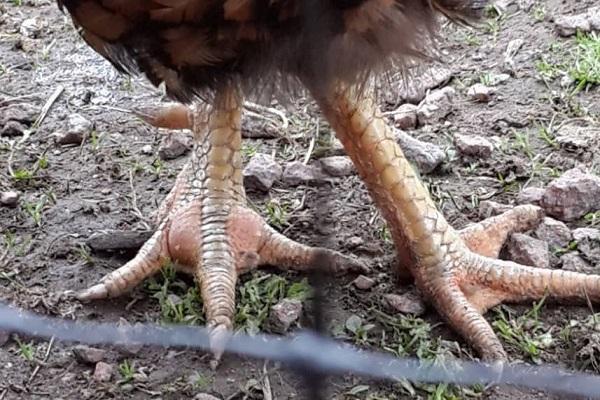
Gout or urolithiasis diathesis
Diathesis or gout occurs in young animals as a result of improperly selected feed. The disease manifests itself in the form of growths on the paws. The disease is accompanied by the following symptoms:
- lethargy and lack of appetite;
- legs become swollen, increase in size;
- the bird does not move well.
For treatment, it is necessary to introduce vitamin A into the daily diet. For complex symptoms, it is necessary to solder the bird with a solution of soda for 2 weeks. For an adult, it is necessary to dilute at least 10 grams of the substance with water.
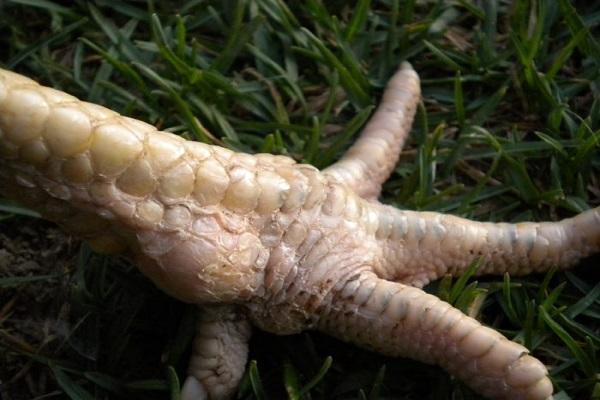
Rickets
The cause of the appearance of the disease is the lack of vitamin D3. The disease most often affects young individuals; in adult chickens, the lack of vitamin occurs in an average form and is manifested by malformed eggs with a thin skin.
Rickets symptoms:
- feathers become tousled;
- the beak becomes soft, which often brings discomfort to the bird while eating;
- diarrhea appears;
- the bird becomes weak and practically does not move.
For treatment, it is necessary to introduce a vitamin into the diet. It is also recommended to regularly walk the birds in the fresh air.
Important. In difficult cases of the disease, it is necessary to use ultraviolet radiation.
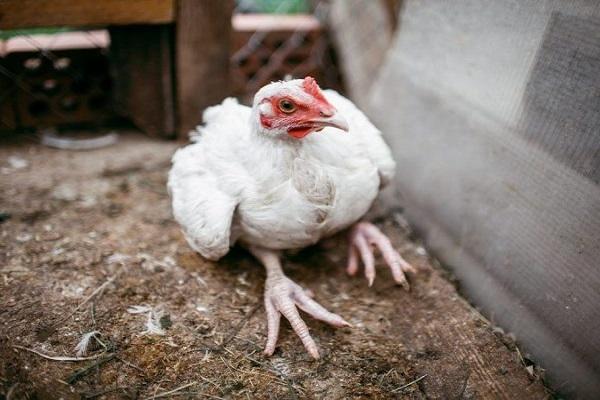
Chicken lame
The disease occurs as a result of physical damage to the limbs. Birds very often damage their paws with sharp objects. The disease can manifest itself as a result of abnormal development or damage to nerve endings. This problem manifests itself with the following symptoms:
- the bird is limping;
- flaps its wings regularly;
- often stops to rest.
In the presence of cuts and wounds, treat with antiseptic drugs. Add a complex vitamin remedy to the daily diet.

Arthritis and tendovaginitis
These diseases have similar symptoms, but require different treatment.
| Description | Symptoms | Treatment | |||
| Arthritis | Tenosynovitis | Arthritis | Tenosynovitis | Arthritis | Tenosynovitis |
| The formation of an inflammatory process in the joints on the paws. The causes of the inflammatory process are infection in the joints on the paws | It is observed in adults. It manifests itself as an inflammatory process of the tendons | The chicken begins to limp on its paw. Most often cannot stand | It manifests itself as small plump formations on the paws. Fever may rise and the bird feels pain when touching the affected area | The use of special supplements that contain trace elements such as calcium, potassium. Antibiotic use | Treatment is with antibiotics, which are prescribed by the veterinarian after examining the affected bird |
These diseases can be cured only in the initial stages. In the absence of timely therapy, the disease cannot be treated.
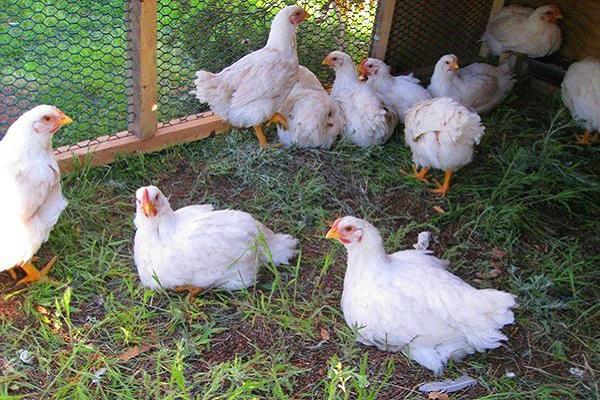
Knemidocoptosis, or scabies
The disease is contagious. When one bird is affected, the entire chicken coop is infected in a short time. The causes of the onset of the disease is a parasite that penetrates the skin and causes the following symptoms:
- growths appear on the legs;
- the paws of the bird are covered with light-colored scales;
- appetite decreases, chickens become indifferent.
Among the methods of treatment, Vishnevsky ointment is often used. Before treatment, the paws are treated with hydrogen peroxide, after which an ointment is applied in a thick layer.
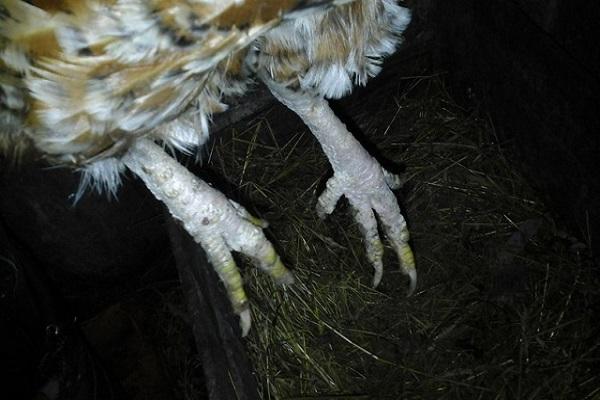
Tendon displacement (perosis)
Often this type of disease appears in chickens during the period of weight gain. The causes of paw disease is a lack of vitamins, including manganese. The problem manifests itself with the following symptoms:
- lack of appetite;
- swelling of the joints;
- compaction of the limbs.
For treatment, a vitamin supplement is used that contains manganese. Also, greens and fish oil should be added to the daily diet.
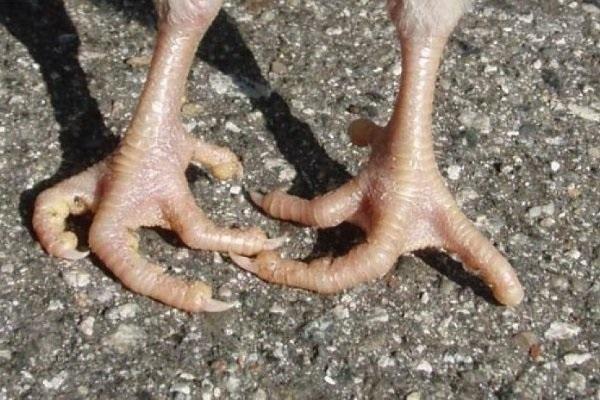
Crooked fingers
Curvature of the fingers is observed in young individuals that are just beginning to develop.The causes of the problem are most often improper care and genetic inheritance. The disease is manifested by the following symptoms:
- curvature of the toes;
- the gait of chickens becomes wobbly.
When this type of problem occurs, there are no drugs that can be used to treat chickens.
Curly fingers
This type of disease is most often manifested as a result of heredity or lack of vitamins. The disease manifests itself in the form of fingers bent inward.
Disease symptoms:
- the toes are curved inward;
- the chicken is limping and does not step on the leg.
The disease does not respond to treatment. When a disease occurs in chickens, drugs can be used that saturate the body with vitamin B.
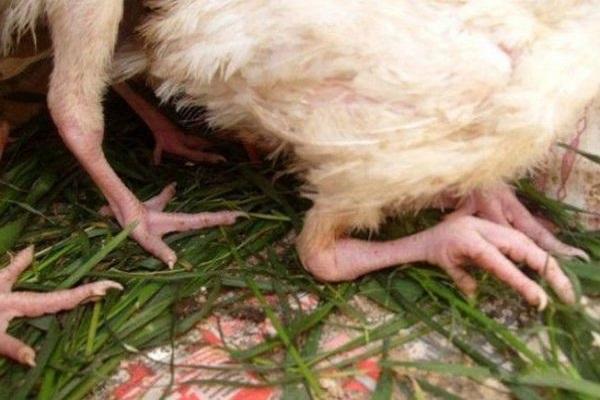
How to identify the problem?
In order to determine the type of problem, you need to carefully read the symptoms. At the first sign of infection, you should contact a veterinary clinic. Your veterinarian will examine you and prescribe the correct treatment.
How to prevent the appearance of diseases?
In order to prevent the onset of leg diseases, the following preventive measures must be taken:
- walk chickens daily and check paws for growths and damage;
- the place for walking and residence of birds must be free;
- saturate the daily diet with essential minerals;
- change the litter regularly;
- in the presence of weak chickens, conduct natural selection.
When purchasing chicks, each chick should be carefully inspected for disease and signs of damage.

Conclusion
Chickens are rarely exposed to diseases, more often birds suffer from leg lesions. Improper care and feeding can cause illness and death of chickens. When the first signs appear, it is necessary to take measures for treatment. Some types of diseases do not respond to treatment and require the removal of birds from the chicken coop.

